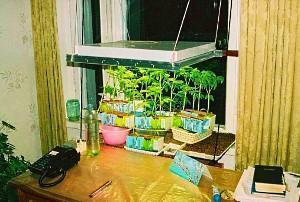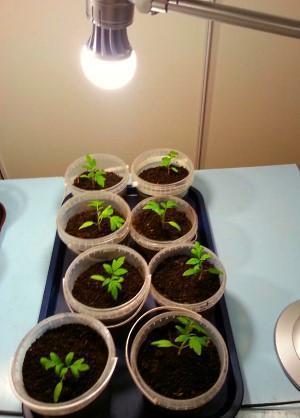Lighting for seedlings at home - a luxury or a necessity?
 The arrival of the long-awaited spring for many summer residents is associated with the beginning of a new gardening season. Its start begins with sowing seeds and growing seedlings most often on the windowsill... On the part of the grower, a lot of time and effort is put into getting good shoots. One of the areas of a successful growing process is the correct lighting of the seedlings at home.
The arrival of the long-awaited spring for many summer residents is associated with the beginning of a new gardening season. Its start begins with sowing seeds and growing seedlings most often on the windowsill... On the part of the grower, a lot of time and effort is put into getting good shoots. One of the areas of a successful growing process is the correct lighting of the seedlings at home.
Lighting for seedlings
Sowing seeds for seedlings usually occurs in January and February. These months are not characterized by good solar activity, and the daylight hours are very small. In addition, if the shoots are to grow on the windowsill of the first floor, or on the north side, then the primary task of the amateur vegetable grower is to organize the lighting of the seedlings at home.
To obtain strong and healthy seedlings, the plant must receive at least 10-14 hours of daylight hours. Natural conditions during this period cannot provide such a light regime. And the seedlings standing on the windowsill begin to vigorously reach for the window. In this case, a sad picture can be observed: the plants become thin, elongated and weak.
Outdated lamps are also used for supplementary lighting of seedlings. But such an option can dramatically dry up young shoots and even burn them. Therefore, when using an incandescent lamp to illuminate seedlings, a certain distance must be observed during installation. The consumption of such lamps of a large amount of electricity and the inability to create the required spectrum of light does not make them effective for supplementary lighting of seedlings at home.
Basic requirements for lighting seedlings
A lamp for supplementary lighting of seedlings must meet the following requirements:
- A certain color spectrum is required for good growth of young plants. When choosing lamps for supplementary lighting of seedlings, it is better to give preference to devices with red or blue rays.
- The main purpose of a lighting source is to illuminate, not dry out and increase the air temperature.
- The beams of the lamp for supplementary lighting of seedlings should be soft and not irritating.
- The seedling container should be evenly lit. Lighting for home seedlings should cover even extreme plants.
To obtain good seedlings, it is important to choose the correct duration and intensity of supplementary lighting for seedlings. The light intensity will depend on the selected lamp power and distance from it to the surface. A simple rule will help to create optimal conditions when installing a lamp for supplementary lighting of seedlings. In order not to overdry the plant, it is necessary to place your hand on the illuminated surface. If warmth is felt, then the device should be removed.
 The most acceptable for plants is the illumination level within 8 thousand lux. Artificially illuminating seedlings at home makes it possible to achieve illumination of up to 6 thousand lux.A similar result can be achieved by illuminating the shoots not only in the morning or in the evening, but also on cloudy days.
The most acceptable for plants is the illumination level within 8 thousand lux. Artificially illuminating seedlings at home makes it possible to achieve illumination of up to 6 thousand lux.A similar result can be achieved by illuminating the shoots not only in the morning or in the evening, but also on cloudy days.
Determining whether a plant needs additional lighting is very simple. To do this, you will need to direct the beam of the device to the seedlings, and if there is no difference between the illuminated and unlit surface, then natural light is enough for young seedlings.
Choosing the spectrum of light
For high-quality photosynthesis of plant cells, the full spectrum of light present in the sun's rays is required. Therefore, artificial lighting of seedlings at home requires maximum identity with sunlight, which contains waves of different lengths and different colors.
Each spectrum has a different effect on plant growth:
- Red-orange light... Under its action, seed germination is accelerated, vegetation improves and flowering is stimulated.
- Violet blue light... Supplementing seedlings at home with such rays helps to increase cell growth and the appearance of strong and short shoots.
- Yellow green... This part of the spectrum is practically not absorbed by plants, since it is reflected from the leaf surface.
How to supplement the seedlings is up to the vegetable grower to decide. The choice will depend on the characteristics of the premises, stage of development, type and variety of culture.
What lamps to choose for lighting seedlings at home?
 Experts are sure that the key to excellent plant growth is illumination. Today the market of lighting devices of this type is represented by a wide variety. However, any vegetable grower will be interested in knowing which lamps to choose for lighting seedlings at home so that they are as efficient as possible and less costly.
Experts are sure that the key to excellent plant growth is illumination. Today the market of lighting devices of this type is represented by a wide variety. However, any vegetable grower will be interested in knowing which lamps to choose for lighting seedlings at home so that they are as efficient as possible and less costly.
Lighting of seedlings with LED lamps. It is this type of lighting that is gaining popularity among summer residents. Since the ratio between efficiency and power consumption is several times higher than the efficiency and economy of incandescent lamps.
When using LED lighting for seedlings, the grower receives the following benefits:
- Low power consumption.
- The light source can be placed at a minimum distance from the plant, since the lamp has a low temperature.
- The light spectrum of red and blue LED bulbs shows the best results when grown.
- Operational safety. If water splashes on the lamp, there will be no temperature drop and breakage.
- High indicators of environmental friendliness of the device.
- There is no infrared radiation.
Supplementary lighting of seedlings with LED lamps allows you to avoid excessive drying of the plant and excessive thermal humidity, which becomes a good environment for the development of fungal diseases.
Lighting of seedlings with energy-saving lamps
 Another best option for a summer resident is to use such devices. The "housekeeper" is a tube with electrodes. Its inner part is filled with inert gas, and the walls are covered with a phosphor. As a result of this design, after the contact of moving electrons of an inert gas and their passage through the phosphor, ultraviolet light is formed.
Another best option for a summer resident is to use such devices. The "housekeeper" is a tube with electrodes. Its inner part is filled with inert gas, and the walls are covered with a phosphor. As a result of this design, after the contact of moving electrons of an inert gas and their passage through the phosphor, ultraviolet light is formed.
Ultraviolet rays are beneficial to the plant. They contribute to a more intensive growth of seedlings, which under their influence become strong and are distinguished by a rich color. Reducing various pathogenic microbes is of no small importance when illuminating seedlings with energy-saving lamps.
Also, the advantages of such devices include the absence of high temperature at the lamp. This allows you to maintain the necessary microclimate around the plants and does not allow the air humidity to rise. Placing energy-saving lamps near seedlings is considered completely safe.
And in conclusion, in addition to the wishes of a successful season, I would like to remind vegetable growers that amateurs can not replace the sun's rays with any artificial light source.Therefore, if possible, be sure to take out the plants under the warm spring sun, which will allow them to become even stronger and more resilient.
Video: the advantages of LED lamps for illuminating seedlings
Valery Medvedev on LED lighting of seedlings

Plants love lighting, only special, none will fit. Plants need lighting of a certain spectrum so that they grow faster and do not get sick. They use LED lamps, but I still have special ultraviolet incandescent lamps. It also does its job well. I have repeatedly observed the development of indoor flowerpots under the influence of LED and my old lamp. What happened? They feel much better under LED lights. Now I will apply modern technologies.
All around they are promoting LEDs, but for some reason they are not used on farms.
This is the tacit answer to the question "why"
So do not be discouraged if your seedlings calmly rise under T8 like Osram 840 or Silvania Grolux. Others generally have T4 840s or E27 navigators from a chandelier.
Of course, LEDs are not the driving force in greenhouses these days. efficiency compared to DNAT is low, but LEDs are much safer for the home. Here is a comparison, for example, a simple LED lamp _ww.gidroponika.su/gidroponika-magazin/lampy-dlja-rastenij/svetodiodnye-lampy-dlja-rastenij/svetodiodnaja-lampa-dlja-rastenij-professional-ledw-grow-lights-25x3 kupit.html is ready, and now imagine the same day, at least 250 watts from the epra in the apartment. I think the difference is obvious.
And I bought smart clinks from Redmond and programmed the lighting to turn on at the right time, ordinary bulbs with an E27 base are inserted there, now my head does not hurt about forgetting to turn on or off the light in time. The year before last, I learned, then the seedlings stretched out from a lack of light, then they dried out from an overabundance. And in the past there were no such problems.